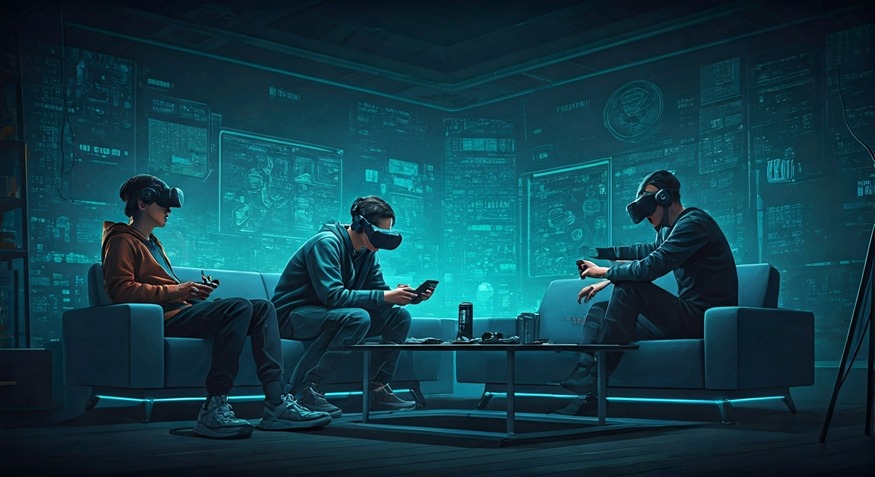How VR + Mobile Gameplay is Shaping Asymmetric Game Design

Key Highlights
- Virtual reality and mobile gameplay are joining together to change how people see asymmetric multiplayer VR games. This change is making a big impact on the world of gaming and game design.
- In asymmetric game design, there are different roles for every player. One person uses immersive virtual reality, while the others play the game on their mobile phones.
- This new type of game uses the latest vr technology and software development. It brings in new ways to play and creates challenges for the people who need to talk with each other in the game.
- Games that do well on platforms like Oculus Rift and pc show how good things can get when VR and mobile work together. The mix opens up more ways to have fun in multiplayer vr games.
- Developers find many new chances, though there are some problems too. They have to think about who can access the games, keeping things fair, and making sure the vr hardware works for everyone in this part of gaming.
Introduction
The world of gaming is shifting fast. New technology and evolving gameplay styles are leading the charge—especially the fusion of virtual reality and mobile play. This combo pulls players deeper into games and opens up new ways to connect with others. As a result, gaming is attracting a wider, more diverse crowd.
Virtual reality isn’t just changing how we play—it’s changing how games are made. Developers now have to think beyond flat screens. To develop a VR game, they must reimagine movement, interaction, and environment from the ground up. It requires designing spaces players can physically explore, creating intuitive controls, and crafting immersive experiences that feel real.
One major trend is the rise of asymmetric games, where players take on different roles or perspectives. These games break the mold of “same experience for everyone,” making multiplayer more dynamic and unpredictable. Combined with VR, asymmetric design opens the door to even richer, more engaging worlds.
The Rise of Asymmetric Gameplay in Modern Gaming
Asymmetric gameplay has become big in gaming today. It changes how people play by giving them new ways to interact with games. When developers use vr technology and mobile platforms, they can make different roles for players. This makes multiplayer vr games more fun and helps keep everyone interested no matter the device they use.
As the world of gaming changes, new design patterns help players work together and use good strategy. You can see this happening in multiplayer vr games or in social vr environments. When players move through their different roles in vr spaces, asymmetric games keep people hooked all over the world.
Defining Asymmetry: What Makes a Game Asymmetric?
Asymmetry in games means that players have different roles, abilities, or goals. This kind of gameplay lets each person have their own way to play and win. It leads to new strategies and makes the experience stand out. This breaks away from normal games, where everyone plays the same way. In those games, gameplay often feels less interesting and limits how much players get involved.
The Fusion of Virtual Reality and Mobile Devices in Gameplay
The mix of virtual reality and mobile devices has changed the way people play games. It lets people get into the action in ways they could not before. By using vr technology, developers can build exciting places in a shared virtual space. Here, players can join in and play together no matter what device they use. This mix helps more people join and play, and it also leads to new ideas in game design. Game makers try out fresh ways of play that connect vr with mobile games. Because of this, players now get a special type of gameplay that is different from old games. The mix of how people work and play together in these new games changes what they think of as normal play.
Innovative Mechanics of VR + Mobile Asymmetric Games
New game ideas are changing the way people play in asymmetric VR and mobile games. Players can have their own roles on each platform. Someone might be in a deep VR world, while another uses touch controls on a mobile device. This makes the game more fun for everyone. There is something special about how the players talk to each other and come up with plans together. The mix of VR technology and mobile gaming brings out new ways to get people to work as a team.
But, there are some challenges. First, games must balance the hard parts of using VR so that they can still be enjoyed by anyone with a mobile device. Not everyone has the same gadgets, so the gameplay has to work for all. Still, trying these new things can be a good move. It could give people a gaming experience that feels fresh, different from the usual types of games. With asymmetric VR, players can get more out of every moment in the game.
Unique Roles for Players on Different Platforms
Asymmetric gameplay gives each player a special role that matches how they use their device. When you play in a vr setup, you get to dive into a virtual world. You use your sense of space, move your body, and touch things inside the game. Using a mobile, you do your part by giving support to the team. You can plan moves or manage game packs from your phone. This mix of roles helps the players work together, but there is still some friendly challenge. By giving everyone a clear job, the gaming feels more fun. Players get to use what they do best. This makes the gameplay in vr and the virtual world more enjoyable for us all.
Interaction Dynamics and Communication Challenges
Interaction in asymmetric gameplay means players must work together, even when their roles and tools are different. Some may be using phones, while a VR player is in a virtual world. The vr player gets a deeper experience with stronger cues, and this might not be the same for people on mobile. This can cause miscommunication, and it can be hard for everyone to coordinate or make a plan.
Good game design should notice these challenges. It needs to help both verbal and non-verbal communication. Developers must make sure the game feels inclusive to all. The goal is to bring the different ways of playing together. In the end, all participants in the gameplay, including the vr player, should feel part of the gaming action, no matter which platform they use.
Notable Examples of Asymmetric Games Using VR and Mobile
Some top titles show how VR and mobile gameplay can come together in smart ways. For example, “Rec Room” lets people join social VR and play with different roles. This setup makes how people act with each other better and more fun. Then, there is “Panoptic.” In this game, one person puts on a VR headset and acts as the Overseer. The other person uses a mobile phone and plays as a small challenger. These games have fresh gameplay ideas that make the most of VR and show what can happen with asymmetric designs. This helps make gaming more interesting and gives everyone new ways to play with others. Over time, it also changes what people expect in multiplayer games.
Success Stories and Standout Titles in the Genre
Several games stand out as early examples of how asymmetric gameplay can work well, using both VR and mobile platforms. Games like “Panoptic” show how observers and players can have different roles, which adds tension and fun. “Half + Half” gives people a space to play together in many ways, each taking on unique roles. “Rec Room” shows how much VR can help people connect and be creative with others. All these standout titles show that the mix of VR, new gameplay styles, and game design is opening up many exciting options for interactive stories and fun.
How Gameplay Differs from Traditional Co-op Experiences
Gameplay in asymmetric VR and mobile games is not like what you find in most multiplayer VR games. In these games, each player gets a different job or task, and this is seen most between the vr player and people on mobile. Traditional co-op games let all players do about the same things. But in asymmetric multiplayer vr games, the vr player often has new ways to play or special skills in the virtual world. This makes every player see the game in a different way. The vr player may get better tools or have more information to use in the virtual world. This kind of setup can change what happens in the game and gives the players more to think about. It helps people in the game work together but in different ways. So, asymmetric vr gives a new level of teamwork and fun that most multiplayer vr games do not offer.
Design Challenges and Opportunities for Developers
Balancing player engagement and keeping things easy for everyone can be tough in asymmetric VR and mobile game design. Virtual reality developers must deal with the challenges of software development and also make sure gameplay feels simple on all kinds of VR platforms. There are chances to use new design patterns and technology. This can help make better and more immersive experiences for both VR players and people using mobile devices. By using what virtual reality can offer, developers can make new ways to play and interact, helping multiplayer VR games and asymmetric VR move forward. This also helps make the experience richer for all players.
Balancing Player Engagement, Accessibility, and Technology
Getting the right mix of player engagement, accessibility, and vr technology is important for anyone making asymmetric vr games. Developers need to make sure every player can get into the game and have fun. No matter what platform people use, game design should help each person take part and enjoy it.
Accessibility in gaming should help all kinds of players, from casual gamers to those who play a lot. Adding features that welcome everyone is the way to bring in more people. Using vr technology to build simple, easy-to-use controls will help people feel part of the virtual world.
This lets everyone get more out of the vr gameplay and keeps them coming back. If developers focus on these things, they can give all players a better game design. Games will have smoother gameplay for everyone and a more exciting virtual world to dive into.
Conclusion
The way asymmetric games are changing, thanks to the mix of virtual reality and mobile platforms, shows a big change in game design. The people who make these games face some tough problems. They need to keep players interested and work with the limits of the technology. Still, the room for new and exciting gameplay is large. As VR technology and team gameplay keep getting better, asymmetric games will keep growing. The future looks good. Gamers will find themselves in new worlds of fun and interactive experiences that did not exist before. This is an exciting time in vr and virtual reality game design.
Frequently Asked Questions
What hardware is required to play asymmetric VR and mobile games?
To play asymmetric VR and mobile games, you need a VR headset that works with your gaming system. You also need a smartphone or tablet for mobile gameplay. Make sure you have a steady internet connection. Sometimes, extra devices like controllers or motion sensors can make the vr gaming feel even better. This setup helps people get more out of the gameplay and enjoy the asymmetric vr experience.
How do developers make asymmetric games fair and fun for all players?
Developers work to keep things fair and fun in asymmetric games. They do this by having balanced gameplay, different roles for players, and changing how hard the game is when needed. The team pays close attention to what people say about the game and use data to make things better. This helps keep everyone interested and deals with the special things that happen in vr and mobile gameplay.
What trends or future advancements are shaping this genre?
Emerging technologies like 5G, better AI, and modern haptic feedback are changing the way we look at gameplay. These new trends help to make player interactions stronger and more fun. They also let game design teams be more creative. This opens up new ways for the future of vr and mobile games to work together. The way we play games keeps getting better because of all these new ideas and tech.




